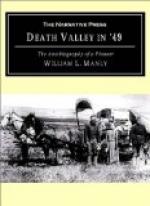He told us that we must decide the next day. When we came to the road where we were to separate he filed off on his road and the others filed off on their road and then came back with their whips in their hands. I had filed in after Hunt, and they tried to convince me that I was very wrong. A Mr. Norton of Adrian, Mich., promised Mrs. Erkson a horse to ride if she would go, and so I left Hunt and turned in on the other road, the hindmost wagon. This is going back a little with the history and bringing it up to Mt. Misery. On my way back from Mt. Misery I climbed up on a big rock and inscribed the date—Nov. 10, 1849.
In our journey we came to what is called ‘The rim of the Basin,’ and traveled along on that a distance till we came to the Santa Clara River and saw where the Indians had raised corn and melons. We followed on down that stream and found our teams gradually failing. Noting this we decided to overhaul our loads and reject a lot of things not strictly necessary to preserve life. I know I threw out a good many valuable and pretty things by the roadside. I remember six volumes of Rollin’s Ancient History, nicely bound, with my name on the back, that were piled up and left. We followed along near the Santa Clara River till it emptied into the Virgin River. It was somewhere along here that we first saw some Yucca trees. The boys often set fire to them to see them burn.
The Virgin River was a small stream running on about the course we wanted to travel, and we followed this course for thirty or forty miles. We found plenty of wood and water and mesquite. After awhile the river turned off to the left, while we wanted to keep to the right, so we parted company there. We heard of a river beyond which they called the ‘Big Muddy’ and we went up a little arroyo, then over a divide to some table land that led us down to the Big Muddy. We made our wagons as light as possible, taking off all the boards and stakes we could possibly get along without. Wm. Philipps and others were placed on short allowance. They had an idea that I had more provisions in my wagon than I ought to have, but I told them that it was clothing that we used to sleep on. I divided among them once or twice. When we reached the Muddy we stopped two or three days for there was plenty of feed. It was a narrow stream that seemed as if it must come from springs. It was narrow between banks, but ran pretty deep, and a streak of fog marked its course in the morning. We understood it was not very far from where we left the Virgin River to the Colorado, some said not more than fourteen miles and that the Colorado turned sharply to the south at that point. Mr. Rhynierson and wife had a child born to them on the Virgin River, and it was named Virginia.
It was a gloomy trip the whole time on the Muddy. I lost three or four head of cattle, all within a day and a night. Mrs. Erkson walked to lighten the load, and would pick all the bunches of grass she saw and put them on the wagon to feed the oxen when we stopped. I let them pass me and stopped and fed the cattle, and slept ourselves. It was said that we ran great risks from Indians, but we did not see any. I had at this time only two yoke of oxen left.




